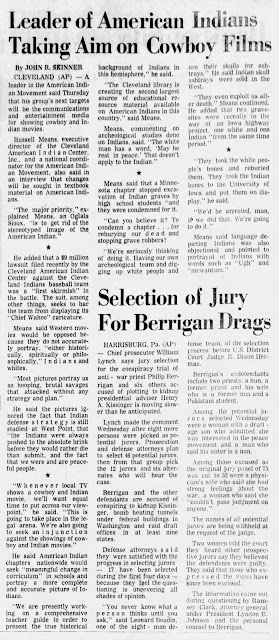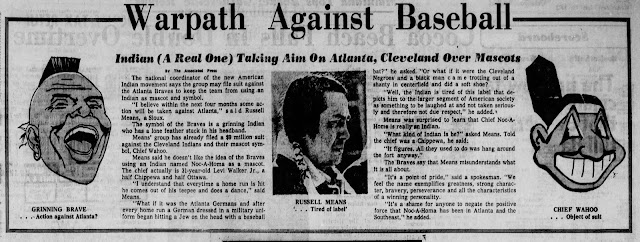1972 Chief Means no say other tribe run elbows with his. He say other tribe smoke peace pipe with pale face and no fight. He say they injun Uncle Toms. Me know. Me hang around Fort, too.”
Readers respond to Russell Means:
- The first letter poked fun at the issue by saying that state and city names should be changed, since Means wanted to end the use of sporting teams exploiting Native Americans. “Hey, here’s a better solution, why don’t we invite Russell Means to Florida and get him a RESERVATION in CHATTAHOOCHEE where he belongs.” – Don Murray
- Another mocked Native people in general. “Chief Wau Chula: Wah Hoo! Yo make um heap big boo boo. No can read um smoke signals. Chief Means no say other tribe run elbows with his. He say other tribe smoke peace pipe with pale face and no fight. He say they injun Uncle Toms. Me know. Me hang around Fort, too.” – His Sign (For Chief Tall Vast) -- The editor responded with “Indian militant seems to put his own scalp in more danger than those of the white-eyes. Response here has been that the Morning After’s vast Indian reading segment favors the good times of today with the pale faces instead of the good ole days where the deer and buffalo roam and there’s no national television to take up their cause.”
- “Dear Mr McEwen: Your comments about Russell Means (ugg!!) and the practice of certain athletic teams using Indian names and symbols are heap good. It’s Means’ comments that have most of us Indians laughing in our teepees. Me likum your comments. He talk like Papoose. No Paleface I know wants to show any disrespect to any of our warrior friends, or to their squaws either. Surely this Russell Means is way off his reservation. Maybe he drunkum too fire water. In speaking of Means Chief Rattle Belly of the Cherokees once said: “Heap big smoke and no fire.” – Chief Sinclair Eaton Sr.
 |
| 1972 Jan 26, The Tampa Tribune |
Leader of American Indians
Taking Aim on Cowboy Film
By John R. Skinner
1972 Jan 28, News Journal
Cleveland – A leader in the American Indian Movement said... that his group’s next targets will be the communications and entertainment media for showing cowboy and Indian movies.Russell Means, executive director of the Cleveland American Indian Center, Inc, and a national coordinator for the American Indian Movement, also said in an interview that changes will be sought in textbook material on American Indians. “The major priority,” explained Means, an Oglala Sioux, “is to get rid of the stereotyped image of the American Indian.” …
Means said Western movies would be opposed because they do not accurately portray, “either historically, spiritually or philosophically,” Indians and whites. “Most pictures portray us as hooping, brutal savages that attacked without any strategy and plan.” He said the pictures ignored the fact that Indian defense strategy is still studied at West Point, that “the Indians were always pushed to the absolute brink before they would rather die than submit, and the fact that we were and are peaceful people. “Whenever local TV shows a cowboy and Indian movie, we’ll want equal time to put across our viewpoint,” he said. “This is going to take place in the legal arena. We’re also going to seek an injunction against the showings of cowboy and Indian movies.”

Indian Vs. 'Indians':
Matter of Sensitivity
by Ira Berkow
1972 Jan 29, The Times and Democrat
New York – Until recently, the only time this country has even taken the Indians seriously was when they surrounded our covered wagons or were in the thick of the pennant race.But now the American Indians – some American Indians, anyway – are taking a new look at their image. They look for example at the grinning Chief Wahoo symbol of the Cleveland Indians baseball team, and find it “demeaning, degrading and racist.” A Sioux, Russell Means, executive director of the American Indian Center of Cleveland, recently filed for a $9 million damage suit against the local baseball club to prohibit the use of its Chief Wahoo symbol.
“It epitomizes the stereotyped image of the American Indian,” said Means. “It attacks the cultural heritage of the American Indian and destroys Indian pride.”
This comes as laughable irony to those who have never had the vaguest notion that there was anything but harmless fun in the comic, long-nosed visage of Chief Wahoo. Perhaps only if one is an American Indian would the thought have occurred.
There seems no malice aforethought to naming teams, from high schools to pro sports, Braves, Redskins, Black Hawks, Redmen, Warriors, and so forth. But ignorance, in most cases, in no defense in the courts. Nor in personal interaction.
“It is not our intent,” said a Kansas City Chief spokesman, “to ridicule the Indian.”
There are arguments, in fact, to the contrary. Team names are often chosen to personify some kind of special skill, physically or mentally. “Lions” and “Tigers” are ferocious. “Giants” are overpowering. “SuperSonics” are speedy. “Dodgers” are clever. “Astros” are heavenly.
Other times, teams are named for some kind of local phenomenon. “Dolphins,” “Suns,” “Mets” may be included in those categories.
And one wonders if the Indians’ action might not elicit a deluge of suits be sensitive partisans, such as a flock of “Padres,” a roundup of “Cowboys,” a bibulation of “Brewers,” a schizophrenia of “Twins,” and a wave of “Patriots,” a consecration of “Saints.”
The Indian-like appellations can, in fact, be construed as complimentary. Boy Scouts consider Indians to be loyal, brave, adroit and Tonto was practically man’s best friend.
However, haven’t Indians usually been a thing apart? Something almost sub-human? Our movies, for example, have generally portrayed the Indians as a painted, scalping savage. A recent trend has been toward such sympathetic movies as “Little Big Man” and such empathetic books as the best-seller about the tragedy of Wounded Knee. But the stereotypes linger on.
Maybe Russell Means is being overly sensitive. Maybe the blacks who successfully sued to get “Amos and Andy” (good fun?) off the air were overly sensitive. Maybe the Anti-Defamation League, the Italian-American League, the Anti-Cruelty Society are overly sensitive.
Maybe, though, oversensitivity comes only after a segment of our population is shunted aside and put, for example, into reservations, and, at best, condescendingly considered “noble savages.” Maybe the shame come in considering someone not like us a gook of sorts.
And who is gookier than toothy Chief Wahoo?
 |
| 1972 Jan 29, The Times and Democrat |
 |
| 1972 Jan 28, News Journal |






Comments
Post a Comment